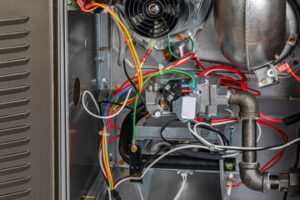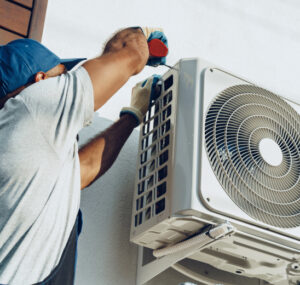Furnaces are made of mechanical components that work together to heat your home. These parts can experience some wear and tear over time and need to be repaired if you want your furnace to continue functioning correctly.

First, ensure your furnace is turned on by checking the power switch connected to it. If it isn’t, you can call Furnace Repair Cincinnati for help.
The furnace is probably one of the most important appliances in your home (besides running water), especially when it comes to keeping you warm. So, when yours isn’t working, it can be a major inconvenience. Luckily, there are many furnace fixes that can be done before you call in a professional, saving you time and money.
If your furnace isn’t turning on, first check the power switch that directly connects to it. You should find this in your home’s breaker box, typically located in the basement or laundry room. It could have been accidentally flipped off, and simply flipping it back on should do the trick. Also, if the switch is off but other electrical devices in your home are still functioning, it could be an issue with your energy supply and you should contact your electric company.
Another possibility is that the thermostat is not set properly. If it is too high or low, it will not register the temperature of your room correctly and may lead to an overworking furnace that burns up energy more quickly than necessary. The first step to resolving this is setting the thermostat a degree or two below your current room temperature. If the problem persists, the thermostat may need to be replaced.
Lastly, you should regularly check your vents and ductwork for blockages that can inhibit airflow and cause the furnace to shut down. Often, this problem is caused by dust buildup or other obstructions that can be easily fixed with a vacuum cleaner and some cleaning spray. You should also periodically inspect and clean your outdoor vents to ensure they are clear of snow, ice, and debris that can limit the flow of air into your house.
Finally, excessive noise is a sure sign that your furnace is in need of repair. If you hear banging, squealing, or humming, it’s likely that you have an electrical problem or the blower motor needs to be repaired or replaced. If you can’t fix the problem yourself, you should always call a trusted Billings HVAC contractor.
Water Leaks
If you notice water around your furnace, it’s time to call for a professional to take a look. This is a sign that something is leaking, dripping or not draining properly and it should be addressed immediately before the problem gets worse. If the water is coming from the primary heat exchanger, it could be a sign of corrosion and it’s best to have a professional replace it as soon as possible. The problem might be caused by a clogged condensation drain, or it may be due to a crack in the secondary heat exchanger. In either case, it’s important to have this issue checked out as soon as possible to prevent a bigger repair bill down the road.
When a condensation leak develops, the water will drip down into the air vent and into your home. It will also accumulate on the floor around your furnace. If you’re not sure where the water is coming from, consider that it could be a drain line from your air conditioner. This happens when you run both your furnace and air conditioning at the same time, which causes excess condensation that pours down a drain line. If the drain line is clogged, it won’t be able to drain the excess condensation, which can cause your furnace to leak.
Another possibility is that the water is originating from a humidifier or from the water lines to your furnace. This is often the case when humidifiers aren’t maintained properly or the lines to the humidifier are corroded.
The first thing you should do when a water leak occurs is to turn off your furnace immediately. This will stop more water from leaking and protect you from an electrical shock. Next, you should try to dry any water pooling on the floor with towels and a mop. If you feel comfortable, you can unscrew the access panel on your furnace and use a wet-dry vacuum to clean up any water inside.
If the leaking is coming from your gas lines, you should immediately shut off your gas at the main valve. You can usually find this located near the furnace or in a basement or garage. Then, you should use a dry cloth to wipe up any moisture that has collected on the floor.
Carbon Monoxide Detector Issues
Carbon monoxide (CO) is a dangerous gas that can be produced by furnaces and other fuel-burning appliances in your home. It is odorless, tasteless, and invisible, which gives it its nickname of the “silent killer.” CO poisoning can cause headaches, dizziness, fatigue, nausea, confusion, and fainting. If these symptoms occur, evacuate the house immediately and call 911.
Furnaces produce CO during the combustion of hydrocarbon fuels like natural gas, but the gas normally escapes out the flue vent. However, if the flue vent becomes damaged or blocked, it can leak carbon monoxide into the home instead. A professional can fix the problem by cleaning the burners and pilot light, ensuring they are burning properly, and replacing the air filter.
You should have carbon monoxide detectors installed throughout the home, particularly near bedrooms. These detectors will alert you to CO in your home and can help save your life if the symptoms of CO poisoning occur. Some common signs of carbon monoxide include a smoky or musty smell, water spots on the windows near the furnace, and a pilot light that is yellow instead of blue.
The best way to prevent carbon monoxide from leaking into the home is to have your furnace professionally maintained and vented at the beginning of each heating season by an HVAC technician. The technician will check the heat exchanger, pilot light, and other parts of the furnace to ensure they are working correctly. They will also inspect the flue vent to make sure it is not blocked and clean it if necessary.
Another preventive measure is to regularly conduct a backdraft test by holding a lit incense stick beside the flue duct. If the smoke rises straight up and out of the vent, there is a good chance that there is a carbon monoxide leak. Additionally, you should have a professional inspect and replace the drive belt in your blower motor to prevent it from becoming frayed or cracked. If you notice that the motor is humming or vibrating, you may need to replace the blower fan motor.
4. Gas Leaks
Gas leaks are another issue that can occur during furnace repair. A furnace’s exhaust piping should be properly insulated and kept free of blockages that can constrict airflow. Furnishings, debris, and bird nests can all be culprits, but a cracked heat exchanger is usually the most serious reason for a gas leak. When the heat exchanger cracks, it releases carbon monoxide and unburned natural gas into your home. If you notice a hissing sound coming from your furnace or the odor of rotten eggs, get outside and call a professional.
You may also notice that your gas bills have jumped or that your home smells different. This could indicate a gas leak or that you have a dirty flame sensor rod. The flame sensor rod is responsible for detecting the pilot flame and triggering safety features that shut down your system. The problem is that dirt, soot, and debris can build up on the rod, causing it to be unable to detect the flame.
Both natural gas and propane are odorless and colorless in their purest forms, but regulations require that they be infused with methanethiol or mercaptans for safety purposes. These additives give off a strong odor that will make you aware of any leaks in your system. If the odor is lingering in your house and can’t be attributed to something else, you should shut off your gas supply valve and open your windows until you can contact a technician.
If you’re not comfortable leaving your home, turn off the gas supply valve located at the gas meter or in front of your house. After you’ve done this, call your local gas company and a heating service to check for any problems.
It’s important to remember that a gas leak is not only dangerous, but it can also be deadly. Exposure to natural gas can lead to dizziness, headaches, fatigue, and nausea. A leak can also cause a fire or carbon monoxide poisoning. By knowing the signs, taking immediate action, and contacting an HVAC expert right away, you can avoid these risks altogether.

